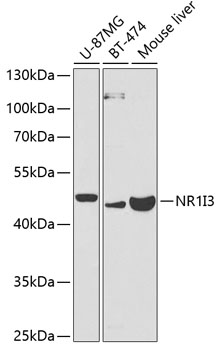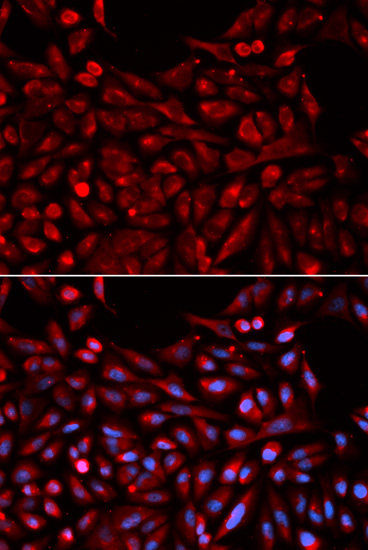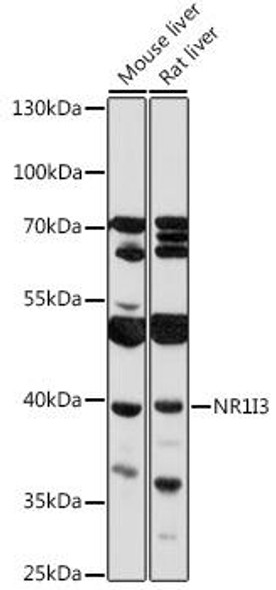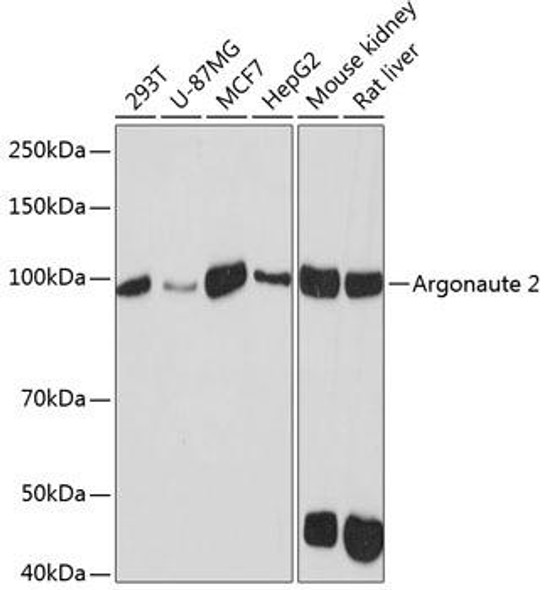Epigenetics & Nuclear Signaling Antibodies 3
Anti-NR1I3 Antibody (CAB1970)
- SKU:
- CAB1970
- Product Type:
- Antibody
- Reactivity:
- Human
- Reactivity:
- Mouse
- Reactivity:
- Rat
- Host Species:
- Rabbit
- Isotype:
- IgG
- Research Area:
- Epigenetics and Nuclear Signaling
Description
| Antibody Name: | Anti-NR1I3 Antibody |
| Antibody SKU: | CAB1970 |
| Antibody Size: | 20uL, 50uL, 100uL |
| Application: | WB IF |
| Reactivity: | Human, Mouse, Rat |
| Host Species: | Rabbit |
| Immunogen: | Recombinant fusion protein containing a sequence corresponding to amino acids 103-352 of human NR1I3 (NP_001070948.1). |
| Application: | WB IF |
| Recommended Dilution: | WB 1:500 - 1:2000 IF 1:50 - 1:200 |
| Reactivity: | Human, Mouse, Rat |
| Positive Samples: | U-87MG, BT-474, Mouse liver |
| Immunogen: | Recombinant fusion protein containing a sequence corresponding to amino acids 103-352 of human NR1I3 (NP_001070948.1). |
| Purification Method: | Affinity purification |
| Storage Buffer: | Store at -20'C. Avoid freeze / thaw cycles. Buffer: PBS with 0.02% sodium azide, 50% glycerol, pH7.3. |
| Isotype: | IgG |
| Sequence: | PVQL SKEQ EELI RTLL GAHT RHMG TMFE QFVQ FRPP AHLF IHHQ PLPT LAPV LPLV THFA DINT FMVL QVIK FTKD LPVF RSLP IEDQ ISLL KGAA VEIC HIVL NTTF CLQT QNFL CGPL RYTI EDGA RVSP TVGF QVEF LELL FHFH GTLR KLQL QEPE YVLL AAMA LFSP DRPG VTQR DEID QLQE EMAL TLQS YIKG QQRR PRDR FLYA KLLG LLAE LRSI NEAY GYQI QHIQ GLSA MMPL LQEI CS |
| Gene ID: | 9970 |
| Uniprot: | Q14994 |
| Cellular Location: | Cytoplasm, Nucleus, cytoskeleton |
| Calculated MW: | 30-40kDa |
| Observed MW: | 45kDa |
| Synonyms: | NR1I3, CAR, CAR1, NR1I3 |
| Background: | This gene encodes a member of the nuclear receptor superfamily, and is a key regulator of xenobiotic and endobiotic metabolism. The protein binds to DNA as a monomer or a heterodimer with the retinoid X receptor and regulates the transcription of target genes involved in drug metabolism and bilirubin clearance, such as cytochrome P450 family members. Unlike most nuclear receptors, this transcriptional regulator is constitutively active in the absence of ligand but is regulated by both agonists and inverse agonists. Ligand binding results in translocation of this protein to the nucleus, where it activates or represses target gene transcription. These ligands include bilirubin, a variety of foreign compounds, steroid hormones, and prescription drugs. Multiple transcript variants encoding different isoforms have been found for this gene. |
| UniProt Protein Function: | NR1I3: Binds and transactivates the retinoic acid response elements that control expression of the retinoic acid receptor beta 2 and alcohol dehydrogenase 3 genes. Transactivates both the phenobarbital responsive element module of the human CYP2B6 gene and the CYP3A4 xenobiotic response element. Interacts with ECT2. Heterodimer of NR1I3 and RXR. Interacts with PSMC4. Directly interacts with DNAJC7. The DNAJC7-NR1I3 complex may also include HSP90. By dexamethasone. Predominantly expressed in liver. Belongs to the nuclear hormone receptor family. NR1 subfamily. 7 isoforms of the human protein are produced by alternative splicing. |
| UniProt Protein Details: | Protein type:Nuclear receptor; DNA-binding Chromosomal Location of Human Ortholog: 1q23.3 Cellular Component: nucleoplasm; cytoskeleton; cytoplasm; cytosol; nucleus Molecular Function:ligand-dependent nuclear receptor activity; androgen receptor activity; DNA binding; zinc ion binding; transcription coactivator activity; thyroid hormone receptor activity; transcription factor activity Biological Process: transcription initiation from RNA polymerase II promoter; intracellular receptor-mediated signaling pathway; androgen receptor signaling pathway; gene expression; steroid hormone mediated signaling; positive regulation of transcription from RNA polymerase II promoter; signal transduction; negative regulation of transcription, DNA-dependent |
| NCBI Summary: | This gene encodes a member of the nuclear receptor superfamily, and is a key regulator of xenobiotic and endobiotic metabolism. The protein binds to DNA as a monomer or a heterodimer with the retinoid X receptor and regulates the transcription of target genes involved in drug metabolism and bilirubin clearance, such as cytochrome P450 family members. Unlike most nuclear receptors, this transcriptional regulator is constitutively active in the absence of ligand but is regulated by both agonists and inverse agonists. Ligand binding results in translocation of this protein to the nucleus, where it activates or represses target gene transcription. These ligands include bilirubin, a variety of foreign compounds, steroid hormones, and prescription drugs. Multiple transcript variants encoding different isoforms have been found for this gene. [provided by RefSeq, Jul 2008] |
| UniProt Code: | Q14994 |
| NCBI GenInfo Identifier: | 49066046 |
| NCBI Gene ID: | 9970 |
| NCBI Accession: | Q14994.2 |
| UniProt Secondary Accession: | Q14994,Q0VAC9, Q4U0F0, E9PB75, E9PC13, E9PDU3, E9PGH6 E9PH10, E9PHC8, E9PHN4, F1D8Q0, F1D8Q1, |
| UniProt Related Accession: | Q14994 |
| Molecular Weight: | 352 |
| NCBI Full Name: | Nuclear receptor subfamily 1 group I member 3 |
| NCBI Synonym Full Names: | nuclear receptor subfamily 1, group I, member 3 |
| NCBI Official Symbol: | NR1I3 |
| NCBI Official Synonym Symbols: | CAR; CAR1; MB67 |
| NCBI Protein Information: | nuclear receptor subfamily 1 group I member 3; constitutive active receptor; constitutive active response; orphan nuclear receptor MB67; orphan nuclear hormone receptor; constitutive androstane receptor; constitutive activator of retinoid response; constitutive androstane nuclear receptor variant 2; constitutive androstane nuclear receptor variant 3; constitutive androstane nuclear receptor variant 4; constitutive androstane nuclear receptor variant 5 |
| UniProt Protein Name: | Nuclear receptor subfamily 1 group I member 3 |
| UniProt Synonym Protein Names: | Constitutive activator of retinoid response; Constitutive active response; Constitutive androstane receptor; CAR; Orphan nuclear receptor MB67 |
| Protein Family: | Nuclear receptor subfamily |
| UniProt Gene Name: | NR1I3 |
| UniProt Entry Name: | NR1I3_HUMAN |
View AllClose








